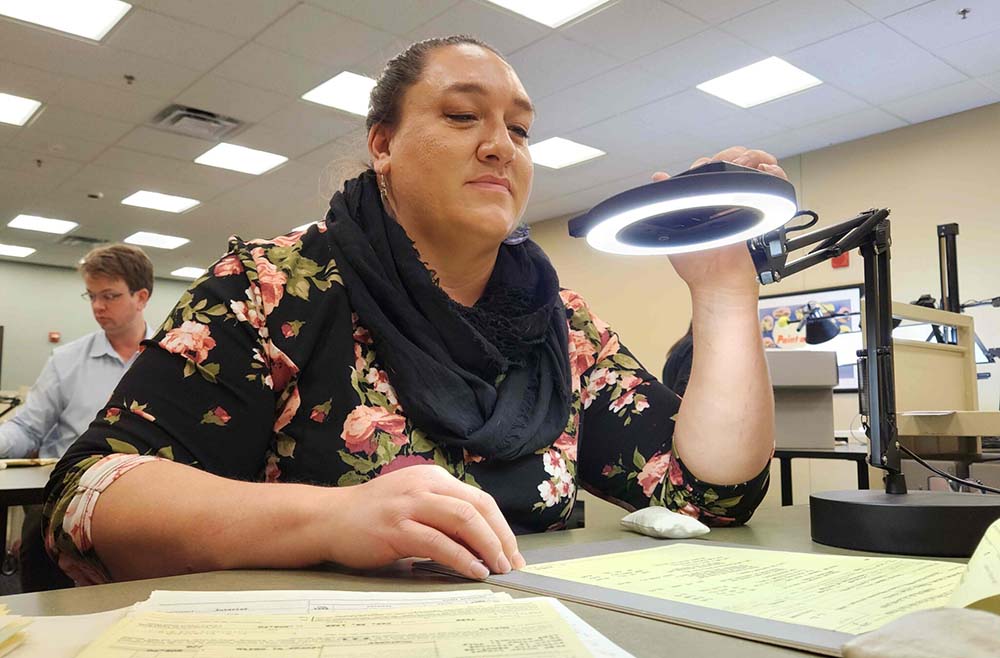
- Details
- By Erin Hemme Froslie, North Dakota Monitor
Researchers are digitizing historical records from a Native American boarding school in Bismarck, aiming to bring information closer to the communities affected by its existence.
This story was originally published in the North Dakota Monitor.
“There’s a hunger to understand this part of our history, to better understand the boarding school era,” said Prairie Rose Seminole, who is part of the team working on the project.
The Bismarck Indian School operated from 1907 to 1937. Most of its students came from Native American reservations in North Dakota. Its records, however, are in the National Archives in Kansas City, Missouri, 600 miles away.
The collection includes boxes of financial records and reports, official correspondence, personnel and staff information, and student records and correspondence. Each piece reveals something about the residential boarding school experience, researchers said.
Until they are digitized, few people whose descendants attended the boarding school have access to the information.
“It’s been emotional to uncover these stories,” said Seminole, a citizen of the Mandan, Hidatsa and Arikara Nation and project coordinator with Northern Plains Heritage Foundation. “Some people in our communities aren’t aware of their descendants’ experiences.”
Dakota Goodhouse, an instructor of Native American studies at United Tribes Technical College in Bismarck, has traveled to Kansas City twice to view and scan the collection. He has also written and presented research on the boarding school.
His research has found that the school was well-run in its early years. In its later years, however, a superintendent refused to take action when local soldiers camped near the school and induced female students to sneak out after dark. This same administrator’s wife also snatched children from reservations without notifying their families and forced them to attend the school.
“Every time I have walked away with this heavy feeling of responsibility to share the stories,” Goodhouse said. “I want people to see these documents for themselves.”
Even the language different parties use in correspondence sheds light into how the school was viewed. Goodhouse, a citizen of the Standing Rock Sioux Tribe, said that in letters students often refer to the school as “jail” while staff and administrators refer to it as a “playroom.”
“It’s necessary for us to see those differences in perspective,” he said.
Seminole spent much of her time in the archives scanning receipts and invoices. She was surprised by how many businesses in the Bismarck area served as vendors to the school, especially during and after the Depression.
“There are a number of businesses that survived because of huge government contracts with the school,” she said.
Both Seminole and Goodhouse were struck by how many names they recognized as they filtered through records.
When he was a child, Goodhouse’s grandmother took him to the site of the Bismarck Indian School, which is now headquarters for the North Dakota National Guard. His grandmother and her younger sister were students at the school. Her sister died there after falling off a swing.
While scanning documents he ran across his grandmother’s name on a list of “Incorrigible Students.” He believes her name landed on the list because of escalating tensions between her and the matron at the time.
“There’s a legacy that’s been omitted,” Goodhouse said. “We need to investigate that and share stories openly.”
Seminole also identified surnames of families she knows well.
“It brings up a lot of feelings,” she said. “What we’re learning is complex.”
The digital work is sponsored by the Northern Plains Heritage Foundation and the Missouri Valley Heritage Alliance-Fort Abraham Lincoln Foundation; and in partnership with Nueta, Hidatsa, Sahnish College, New Town, and United Tribes Technical College in Bismarck.
The researchers said it will take numerous visits to the archives to document all the records. Then there is a question of how to reveal and share the information, some of which is sensitive and disturbing. The team is working with an advisory group to determine the best way to make everything accessible in a respectful way.
“It will be a process,” Seminole said. “Our priorities are education, healing and respect.”
North Dakota Monitor is part of States Newsroom, a nonprofit news network supported by grants and a coalition of donors as a 501c(3) public charity. North Dakota Monitor maintains editorial independence. Contact Editor Amy Dalrymple for questions: [email protected].
Help us defend tribal sovereignty.
At Native News Online, our mission is rooted in telling the stories that strengthen sovereignty and uplift Indigenous voices — not just at year’s end, but every single day.
Because of your generosity last year, we were able to keep our reporters on the ground in tribal communities, at national gatherings and in the halls of Congress — covering the issues that matter most to Indian Country: sovereignty, culture, education, health and economic opportunity.
That support sustained us through a tough year in 2025. Now, as we look to the year ahead, we need your help right now to ensure warrior journalism remains strong — reporting that defends tribal sovereignty, amplifies Native truth, and holds power accountable.
 The stakes couldn't be higher. Your support keeps Native voices heard, Native stories told and Native sovereignty defended.
The stakes couldn't be higher. Your support keeps Native voices heard, Native stories told and Native sovereignty defended.
Stand with Warrior Journalism today.
Levi Rickert (Potawatomi), Editor & Publisher
